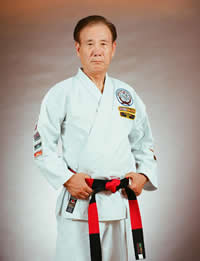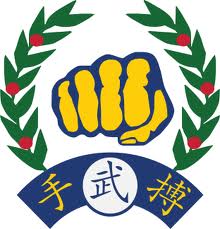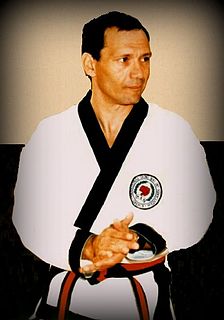
Taekwondo, Tae Kwon Do or Taekwon-Do is a Korean martial art, characterized by punching and kicking techniques, with emphasis on head-height kicks, jumping spinning kicks, and fast kicking techniques. The literal translation for tae kwon do is "kicking," "punching," and "the art or way of."

Jae Chul Shin was a Korean martial artist and founder of the World Tang Soo Do Association.

Korean martial arts are fighting practices and methods which have their place in the history of Korea but have been adapted for use by both military and non-military personnel as a method of personal growth or recreation. The history of Korean martial arts can be traced as far back as the prehistoric era. The ancestors of modern Korean people migrated and settled in the Korean Peninsula as early as the 28th century BC, a geopolitical region besieged by thousands of known documented instances of foreign invasions. Consequently, the Korean people developed unique martial arts and military strategies in order to defend themselves and their territory.

Moo Duk Kwan is the name of a martial art organization founded by Hwang Kee in South Korea in 1945. Licensed Moo Duk Kwan schools teach Soo Bahk Do, formerly Tang Soo Do. 'Moo Duk Kwan' translates as "School of Martial Virtue".

The dan (段) ranking system is used by many Japanese, Okinawan, and martial art organizations to indicate the level of a person's ability within a given system. Used as a ranking system to quantify skill level within a given set of specific patterns, it was originally used at a go school during the Edo period. It is now also used in most modern Japanese fine and martial art.

Tang Soo Do refers to a Korean martial art based on Karate and may include fighting principles from subak, as well as northern Chinese martial arts. Before the Nine Kwans united and formed the martial art Taekwondo, Tang Soo Do was used by select Kwans to identify their Karate-derived martial arts style.
Hwang Kee was one of the most important and influential figures in the Korean martial arts. He was the founder of the school of Tang Soo Do Moo Duk Kwan style.
Rhee Taekwon-Do, also known as Rhee Tae Kwon-Do, Rhee Tae Kwon Do, or Rhee Taekwondo, is a martial art school in Australia and New Zealand teaching the Korean martial art of taekwondo. Its full name is "Rhee International Taekwon-Do (Australia)" or "Rhee International Taekwon-Do ". Chong Chul Rhee, one of the original masters of taekwondo, founded the school in the mid-1960s. Two of Rhee's brothers, Chong Hyup Rhee and Chong Yoon Rhee, later came to assist him in the 1970s.

Korea Taekwondo Association, originally the Korea Tang Soo Do Association (1961), is the first taekwondo organisation. It was founded in 1959, although official South Korean sources give 1961 as its year of establishment. In 1966, some members of the KTA, led by H. H. Choi, broke off from the KTA and formed the International Taekwon-Do Federation (ITF). The Kukkiwon and the then-World Taekwondo Federation were created by the KTA in the early 1970s. The KTA sits under the Korea Sports Council, is aligned with Kukkiwon, and is a Member National Association (MNA) of the WT. Its goal is to promote the martial art taekwondo as a national sport within South Korea.
The Korean terms hyeong, pumsae, and teul are all used to refer to martial arts forms that are typically used in Korean martial arts such as Taekwondo and Tang Soo Do.
Soo Bahk Do (수박도) is a martial art founded and taught by Kwan Jang Nim Hwang Kee, his successor Hwang Hyun Chul, known as H.C. Hwang, and instructors who are certified by member organizations of the World Moo Duk Kwan, Inc. This martial art was originally the ancient martial art of Korea. Hwang Kee created Moo Duk Kwan with influence from "Soo Bahk Do."
Chung Do Kwan, created by Won Kuk Lee in 1944, is one of the first of nine schools or kwan teaching Tang Soo Do, later the school began to teach what came to be known as taekwondo. This style of Tang Soo Do is known for its overall power and emphasis on kicks to the head.
Kwan in Korean literally means building or hall, but when used in martial arts it can also refer to a school or clan of martial artists who follow the same style and/or leader.
Moo Duk Kwan Taekwondo is a modern Korean martial art formed in April 1965 by Kim Young Taek, Hong Chong Soo, and Lee Kang Ik, after a significant group of former students of Hwang Kee chose to leave the original Moo Duk Kwan organization in order to join the Taekwondo unification movement.

Kang Suh Chong was a South-Korean born martial artist and instructor who was a central figure in the establishment of Taekwondo in the United States.

Pat E. Johnson is a 9th degree black belt in the art of American Tang Soo Do. He is the president of the National Tang Soo Do Congress, which was originally created by Chuck Norris in 1973. Johnson is famous for the martial arts choreography in the Karate Kid series in which he also starred as the All Valley Karate Tournament head referee, and has been involved in many films, as choreographer and actor including Enter the Dragon, Teenage Mutant Ninja Turtles, Mortal Kombat, Green Street Hooligans and recently, Punisher: War Zone. He is the 1995 Black Belt Magazine Instructor of the Year.
Hwang Hyun Chul is a ninth-degree navy blue belt in Soo Bahk Do Moo Duk Kwan and the son of the late Hwang Kee, founder of the Soo Bahk Do Moo Duk Kwan system.

Konstantinos Kypriotis was a Greek Martial Artist who was internationally known for his achievements in Tang Soo Do. His first taste of martial arts came in 1968 at the age of 14 as a student at the German-Korean association of martial arts with instructor Mr. M Theodoridis.
American Tang Soo Do is a hybrid martial art formed in 1966 by Chuck Norris who combined the Korean martial art of Tang Soo Do with Japanese styles of Judo, Shito-ryu Karate and Shotokan Karate. Over the years it has been further developed by former black belts of his and their students.

Sun Hwan Chung, also known as James Sun Hwan Chung, is one of the highest-ranking Tang Soo Do, Hapkido, and taekwondo grandmasters in the world. He is founder of the Moo Sool Do form of martial arts and is president of the World Academy of Martial Arts, LLC.










